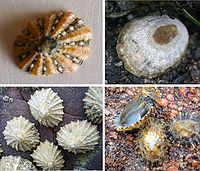
Photo from wikipedia
Aim We use an integrative biogeographical approach to further understand the evolution of an important Southern Ocean marine benthic element, the limpet genus Nacella (Mollusca: Patellogastropoda). Location Southern Ocean. Methods… Click to show full abstract
Aim We use an integrative biogeographical approach to further understand the evolution of an important Southern Ocean marine benthic element, the limpet genus Nacella (Mollusca: Patellogastropoda). Location Southern Ocean. Methods We used multi-locus time-calibrated phylogeny of Nacella at the scale of the whole Southern Ocean to elucidate the underlying processes involved in the origin and diversification of the genus. Results Divergence-time estimates suggest that soon after its origin during the mid-Miocene (c. 12.5 Ma), Nacella separated into two main lineages currently distributed in (1) South America and (2) Antarctica and the sub-Antarctic islands. We identified two pulses of diversification, during the late Miocene (8 to 5.5 Ma) and the Pleistocene (< 1 Ma). Main conclusions Major periods of climatic and oceanographical change strongly affected the biogeography of Nacella and demonstrate both the long- and short-term influence of the Antarctic Circumpolar Current across the Southern Ocean. Our analyses support the validity of all currently recognized Nacella species and reveal a new South-American lineage. This work constitutes the most detailed molecular-based study of an ecologically important, near-shore invertebrate Southern Ocean group and in so doing contributes to the improved understanding of the underlying patterns and processes in the origin and diversification of marine benthic fauna across this globally important region.
Journal Title: Journal of Biogeography
Year Published: 2017
Link to full text (if available)
Share on Social Media: Sign Up to like & get
recommendations!